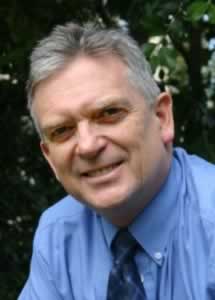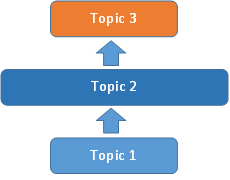There is often insufficient time in the fast paced world of blended learning to create these materials ‘on the fly’
 Self-paced blended learning (and any type of blended learning that provides access for students to “future” learning materials) produces a wonderful “problem” – what should be done with those students who successfully complete the assigned learning quickly?
Self-paced blended learning (and any type of blended learning that provides access for students to “future” learning materials) produces a wonderful “problem” – what should be done with those students who successfully complete the assigned learning quickly?
There are a number of possibilities.
The linear extension model
Linear extension allows students to progress to the next topic. This is a fairly traditional approach; allow the students to progress through the course at an accelerated pace.

Role of the teacher: In this model, the teacher does not have to do anything different; all of the topic materials simply need to be complete and available to students at the beginning of the course.
Assessment when using this model may need to be modified. It works best when the assessment can be individualized and have flexible timing. The student can then be assessed when the topic is learned/completed. Otherwise, a “fast” student may have to take an assessment task many weeks after he/she has completed the topic.
The horizontal extension model
Horizontal extension can be useful when there are advantages with ensuring all students remain on the same topic, such as when all students must be assessed at the same time.
In horizontal extension, “fast” students have access to learning materials that broaden the current topic; they do not move on to a new topic. This wider understanding of the topic may take them into areas of greater complexity, and may contain learning materials that overlap with courses in future years of study. This may convey advantage in future courses, and this is acceptable as these future courses should also contain extension materials.
Analogy:
This can be thought of as taking a set of binoculars to the topic being studied to see beyond the sub-topic under consideration; to scan the horizon for related material.

Example:
In Geography, students may study types of Coastal Landforms. They may learn about capes, coves, bays, etc. and the forces that create them (erosion and deposition).
Horizontal extension may take this topic “wider” to include mountain and glacial landforms (fjords, cirques, etc.), tectonic landforms (rift valleys, ocean trenches, fault scarps, etc.), volcanic landforms (calderas, volcanic cones, etc.) and impact landforms (impact craters, ejecta blankets, etc.). There are many more possibilities, and each topic in each discipline has similar horizontal extension topics.
Role of the teacher: In this model, the teacher must have produced/made available the extension materials; all of these extra materials need be complete and available to students at the beginning of the course. This may take time to plan, research and implement, and this extra preparation time must be allowed for.
Assessment when using this model can be taken by all members of the class at the same time, as all members of the class move from topic to topic at the same time; some students have simply studied the topic in greater detail.
The vertical extension model
Vertical extension also allows students to remain within the same topic. Learning materials provide greater “depth” of learning and much more detail regarding the underlying knowledge.
This is different to horizontal extension.
Analogy:
This can be thought of as taking a microscope to the topic being studied in order to see greater detail.
The current topic (Topic 2) is shown in dark blue. A student who completes Topic 2 quickly moves to the vertically extended sub-topics (Topics 2A, B and C), shaded orange. All students in the class then move to Topic 3 at the same time.
Continuing with the Geography example, students who are studying Coastal Landforms may then focus in more depth on the processes that create these landforms, namely erosion and deposition. This may include waves, longshore currents, rip currents, tides, temperature variations, wind and gravity. Depending on the depth to be covered, students may delve even deeper into factors such as grain size of eroded materials and the impact of speed of water flow, different types of base rocks and the materials they are made of, their hardness and density, and how this impacts the type of landforms, etc. The list of possible areas of study is extensive.
Role of the teacher: In this model, the teacher has to have produced/made available the extension materials; all of these extra materials need be complete and available to students at the beginning of the course. This may take time to plan, research and implement, and this extra preparation time must be allowed for.
Assessment under this model is similar to that in the horizontal extension model; assessment can be taken by all students at the same time, as the extended students have simply studied the topic in more detail.
The teleport extension model
Teleport extension allows a student to move to a completely unrelated area of learning. This new area is not related to the current topic, or even the next topic of study. However, it remains within the discipline.
Analogy:
This can be thought of as something from a science fiction movie, with the learner being teleported to another location of study; a completely different area of study that holds some interest to him/her. The student is no longer in the same location as the binoculars or microscope mentioned in the previous models, but is in a completely different learning landscape.
Example:
Continuing with the Geography example, a student may then decide to study Language geography (a “big” teleport). This studies the geographic distribution of languages. One component of this is how geographical barriers have impacted the spread of languages, and the isolation that has separated languages and dialects. Obviously, many more possibilities exist.
A “smaller” teleport may be the study of tectonic processes (rather than just tectonic landforms as in the previous model); this may involve the study of plate tectonics, volcanoes, earthquakes, etc. involved in the formation of landforms unrelated to the coastal landforms being studied.
Role of the teacher: In this model, the teacher does not have to prepare learning materials; the student negotiates a topic with the teacher and then researches it by him/herself. The teacher and the student would also have to agree on a “deliverable”; what the student will have to show for the learning once completed. This may range from a discussion with the teacher explaining what has been learned, to sharing research notes that have been taken, to a written or multi-modal assignment or even a presentation to the other members of the class. There are many possibilities from ranging from informal to formal.
Assessment under this model is similar to that in the linear extension model. Ideally the assessment should have flexible timing.
Combinations of these models are obviously possible.
Conclusion
Effective teachers have been implementing these models (to a certain extent, and sometimes in an ad hoc fashion) ever since teaching began. However, blended learning makes it more important to formalize our understanding of these options so that teachers can choose the model that best suits their situation, and then have the model (and associated learning materials where necessary) prepared in advance for those students who work through topics at a rapid and effective pace. There is often insufficient time in the fast paced world of blended learning to create these materials “on the fly.”
Peter West is Director of eLearning at Saint Stephen’s College in Australia. He has over 15 years’ experience leading K-12 schools in technology enhanced education, particularly blended learning using online learning environments. He can be contacted at pwest@ssc.qld.edu.au.
- The traditional classroom works so why change it? - February 23, 2017
- Are outdated computers reverting students to a prehistoric era? - November 17, 2016
- Blended learning and the paradox of the experienced teacher - September 30, 2014




Comments are closed.